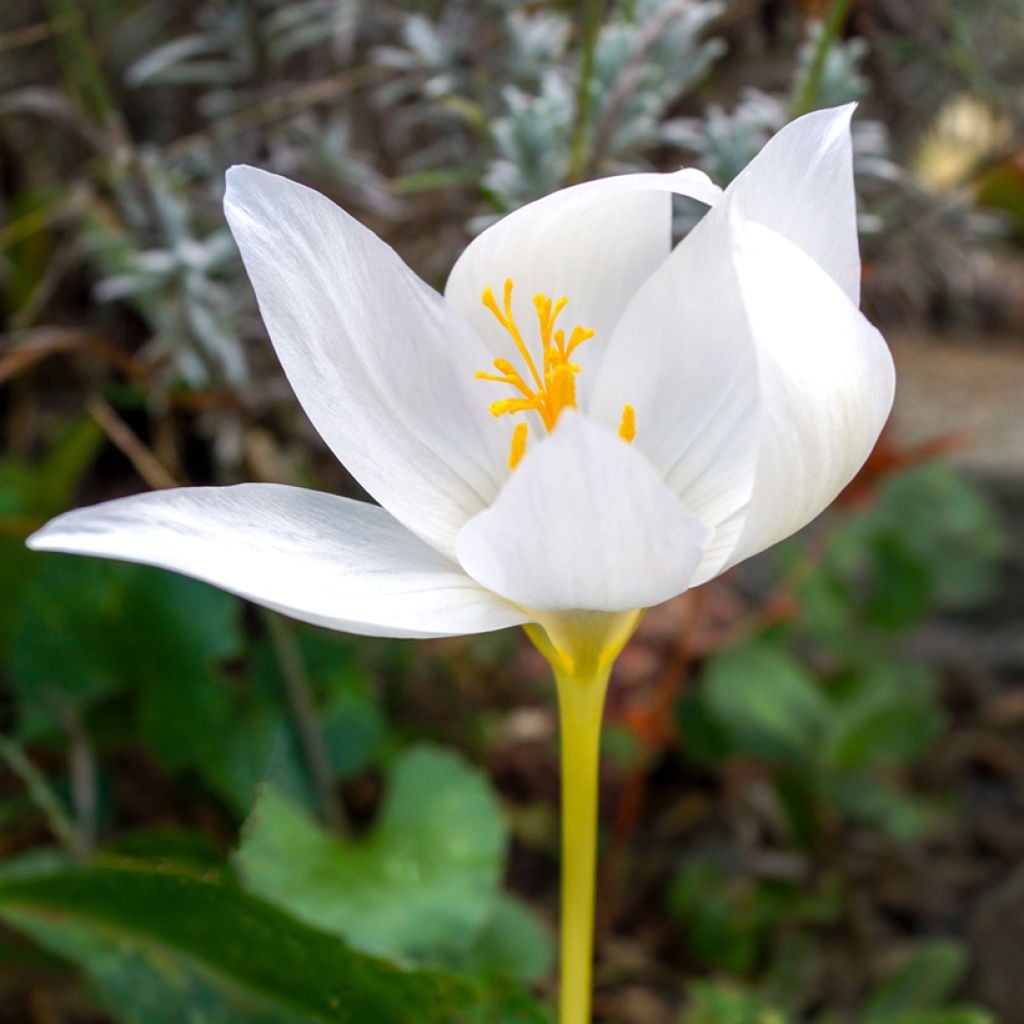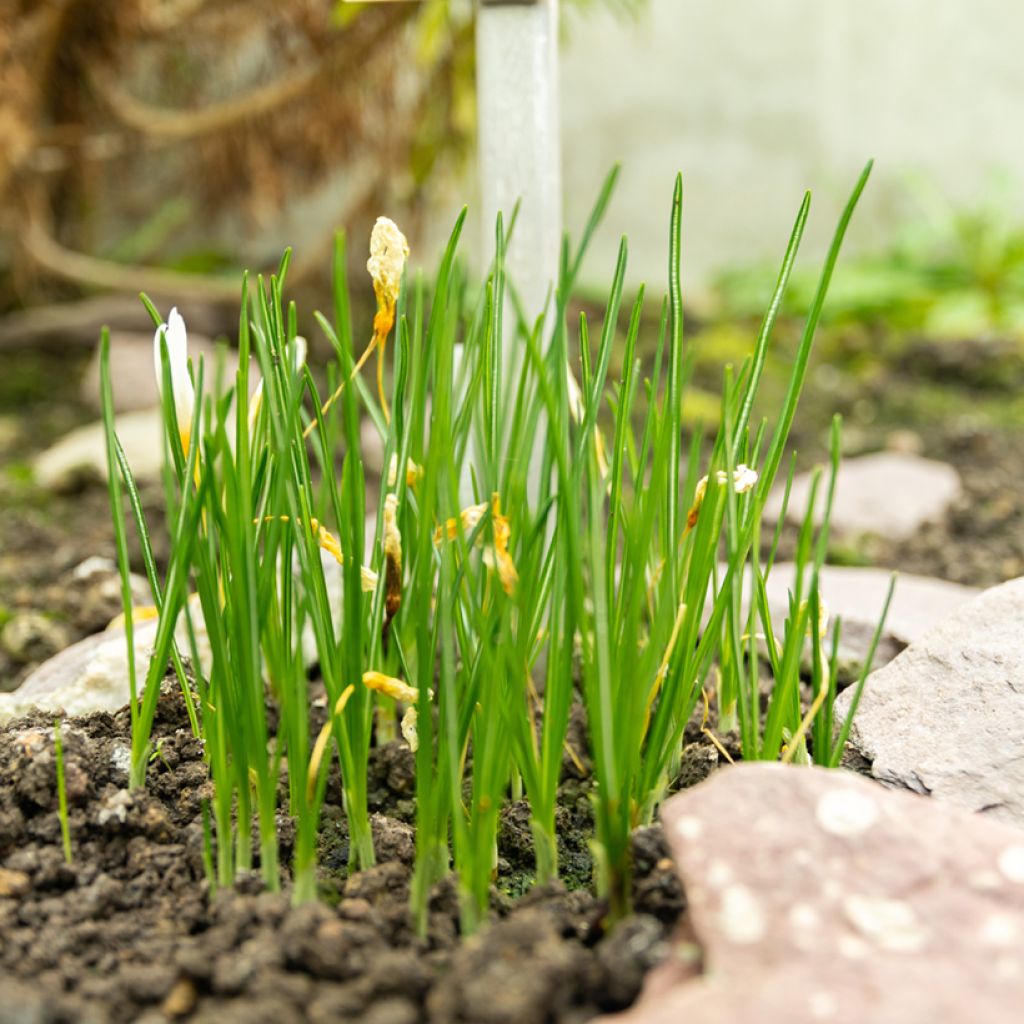

Crocus ochroleucus


Crocus ochroleucus
Crocus ochroleucus
Crocus ochroleucus
White Autumn Crocus, straw-coloured crocus
This plant carries a 6 months recovery warranty
More information
We guarantee the quality of our plants for a full growing cycle, and will replace at our expense any plant that fails to recover under normal climatic and planting conditions.
From €5.90 for pickup delivery and €6.90 for home delivery
Express home delivery from €8.90.
Does this plant fit my garden?
Set up your Plantfit profile →
Description
Crocus ochroleucus is a botanical species from Syria, Lebanon, and northern Israel that blooms in the heart of autumn, in October-November. This rarely planted species is known for its ability to multiply rapidly and its ease of cultivation in very well-drained soil, dry in summer. Its small, bright cream white flowers open repeatedly whenever the weather allows, over a long period. It can be planted in a rock garden, a gravel garden, a raised bed, or even in a lawn in favourable climates. The hardiness of this crocus is estimated at -17 °C.
Crocus ochroleucus belongs to the iris family like other crocuses. This species, native to the Middle East, naturally grows in rocky hills. Despite its origin, it is cold-resistant. Its corms descend deeply, which protects them from the cold and rodents. And summer drought is not a problem, quite the opposite.
Crocus ochroleucus blooms between late October and early December, depending on the climate. Each bulb produces several, 3-4 cm tall flowers, carried by a long tube. They emerge from the ground at the same time as the leaves develop. The elongated cup-shaped flowers are composed of 6 cream-white petals with a yellow base. They open to reveal a yellow throat. The flowers close at night and in rainy weather, then open wide in the sun. The foliage consists of fine, linear, single, alternate, medium green leaves, with a prominent central vein. The 'bulbs' are actually corms covered by a skin of parallel fibres. A corm is, in plant morphology, an underground storage organ that looks like a bulb but is formed by a swollen stem surrounded by fibrous skin. This ochroleuca variety produces many small baby corms and freely self-seeds in light soil.
Botanical crocuses are particularly suitable for naturalisation through sowing in wild meadows or under deciduous trees. Crocus ochroleucus will brighten up the short days of autumn. It will thrive and naturalise in the sun in any very well-drained soil. Combine autumn crocuses with spring crocuses to enjoy multiple flowerings throughout the year. Some ideas for combinations: with blanda anemones and Naples cyclamens, or other small spring bulbs like tulips and botanical narcissus.
A tip for crocuses: the roots have the particular ability to contract like a spring, allowing the plant to settle at the ideal depth for the plant.
Report an error about the product description
Crocus ochroleucus in pictures


Plant habit
Flowering
Foliage
Botanical data
Crocus
ochroleucus
Iridaceae
White Autumn Crocus, straw-coloured crocus
Middle East
Planting and care
Plant the small bulbs of Crocus ochroleuca before 20th September, in light and well-drained soil, enriched with compost, at a depth of 5-6 cm and spaced 8 cm apart or in groups of three every 15 to 20 cm. It is preferable to leave them in place. They will form increasingly floriferous clumps and self-seed. Consider making a few pots for your terrace. Crocus ochroleuca grows in very well-drained, rocky or sandy soils and prefers a very sunny exposure that allows for the complete opening of the corollas. It can tolerate temperatures down to about -15°C (probably more) and summer drought when it is dormant. The crocus requires no special maintenance. Be careful not to cut the foliage before it turns yellow. Corms are susceptible to excess moisture, which can cause them to rot during their dormant period. Rodents are fond of these corms, and snails and slugs feed on all aerial parts of the plant.
Planting period
Intended location
Care
This item has not been reviewed yet - be the first to leave a review about it.
Haven't found what you were looking for?
Hardiness is the lowest winter temperature a plant can endure without suffering serious damage or even dying. However, hardiness is affected by location (a sheltered area, such as a patio), protection (winter cover) and soil type (hardiness is improved by well-drained soil).

Photo Sharing Terms & Conditions
In order to encourage gardeners to interact and share their experiences, Promesse de fleurs offers various media enabling content to be uploaded onto its Site - in particular via the ‘Photo sharing’ module.
The User agrees to refrain from:
- Posting any content that is illegal, prejudicial, insulting, racist, inciteful to hatred, revisionist, contrary to public decency, that infringes on privacy or on the privacy rights of third parties, in particular the publicity rights of persons and goods, intellectual property rights, or the right to privacy.
- Submitting content on behalf of a third party;
- Impersonate the identity of a third party and/or publish any personal information about a third party;
In general, the User undertakes to refrain from any unethical behaviour.
All Content (in particular text, comments, files, images, photos, videos, creative works, etc.), which may be subject to property or intellectual property rights, image or other private rights, shall remain the property of the User, subject to the limited rights granted by the terms of the licence granted by Promesse de fleurs as stated below. Users are at liberty to publish or not to publish such Content on the Site, notably via the ‘Photo Sharing’ facility, and accept that this Content shall be made public and freely accessible, notably on the Internet.
Users further acknowledge, undertake to have ,and guarantee that they hold all necessary rights and permissions to publish such material on the Site, in particular with regard to the legislation in force pertaining to any privacy, property, intellectual property, image, or contractual rights, or rights of any other nature. By publishing such Content on the Site, Users acknowledge accepting full liability as publishers of the Content within the meaning of the law, and grant Promesse de fleurs, free of charge, an inclusive, worldwide licence for the said Content for the entire duration of its publication, including all reproduction, representation, up/downloading, displaying, performing, transmission, and storage rights.
Users also grant permission for their name to be linked to the Content and accept that this link may not always be made available.
By engaging in posting material, Users consent to their Content becoming automatically accessible on the Internet, in particular on other sites and/or blogs and/or web pages of the Promesse de fleurs site, including in particular social pages and the Promesse de fleurs catalogue.
Users may secure the removal of entrusted content free of charge by issuing a simple request via our contact form.
The flowering period indicated on our website applies to countries and regions located in USDA zone 8 (France, the United Kingdom, Ireland, the Netherlands, etc.)
It will vary according to where you live:
- In zones 9 to 10 (Italy, Spain, Greece, etc.), flowering will occur about 2 to 4 weeks earlier.
- In zones 6 to 7 (Germany, Poland, Slovenia, and lower mountainous regions), flowering will be delayed by 2 to 3 weeks.
- In zone 5 (Central Europe, Scandinavia), blooming will be delayed by 3 to 5 weeks.
In temperate climates, pruning of spring-flowering shrubs (forsythia, spireas, etc.) should be done just after flowering.
Pruning of summer-flowering shrubs (Indian Lilac, Perovskia, etc.) can be done in winter or spring.
In cold regions as well as with frost-sensitive plants, avoid pruning too early when severe frosts may still occur.
The planting period indicated on our website applies to countries and regions located in USDA zone 8 (France, United Kingdom, Ireland, Netherlands).
It will vary according to where you live:
- In Mediterranean zones (Marseille, Madrid, Milan, etc.), autumn and winter are the best planting periods.
- In continental zones (Strasbourg, Munich, Vienna, etc.), delay planting by 2 to 3 weeks in spring and bring it forward by 2 to 4 weeks in autumn.
- In mountainous regions (the Alps, Pyrenees, Carpathians, etc.), it is best to plant in late spring (May-June) or late summer (August-September).
The harvesting period indicated on our website applies to countries and regions in USDA zone 8 (France, England, Ireland, the Netherlands).
In colder areas (Scandinavia, Poland, Austria...) fruit and vegetable harvests are likely to be delayed by 3-4 weeks.
In warmer areas (Italy, Spain, Greece, etc.), harvesting will probably take place earlier, depending on weather conditions.
The sowing periods indicated on our website apply to countries and regions within USDA Zone 8 (France, UK, Ireland, Netherlands).
In colder areas (Scandinavia, Poland, Austria...), delay any outdoor sowing by 3-4 weeks, or sow under glass.
In warmer climes (Italy, Spain, Greece, etc.), bring outdoor sowing forward by a few weeks.



































